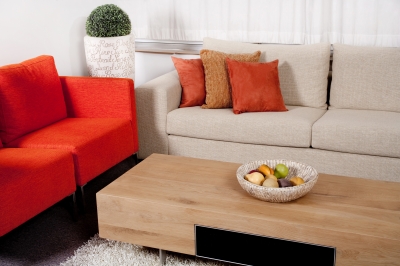The most common complaint about rooms is that they feel too small. Perhaps it’s the layout of the furniture, the awkward shape of the room, or maybe they really are small. No matter the issue, there’s a number of things you can to do maximise the space within a room.
Dealing With Awkwardly-Shaped Rooms
As houses undergo renovation after renovation, strange floorplans begin to emerge as new owners get rid of fireplaces, install second bathrooms and create walk-in wardrobes. Unless you’re buying a newly-built home, it’s likely that you’ll inherit some odd characteristics in at least one of your rooms.

Awkwardly-shaped rooms are prone to ‘dead’ space, that is, areas of the room that are not used for any purpose including storage. Yet oddly shaped rooms are some of the most ideal as you can often give them multiple purposes simple by effectively partitioning the space. You can use screens or partitions, but a better way to achieve partitioning is to utilise the furniture layout to block off sections of the room.
You should also avoid geometric patterns on the walls, especially stripes, as these will highlight odd areas and strange angles. Consider using small-print wallpaper or painting the room in a single, uniform colour so as not to disrupt the eye.
Smart Storage Solutions
Clutter is the single most effective way of making a room feel cramped; even large rooms with lots of exposed items will feel untidy and claustrophobic. Using smart storage solutions can help reduce the amount of clutter present in the room.
For small spaces, choose open-backed bookshelves to hold your books and trinkets so the case doesn’t appear to dominate and close off the room. Investigate clever storage units that can hold many items in a practical, compact manner and make sure the unit is in the same colour as the walls so it can blend seamlessly with the room.
You may also wish to consider modular furniture to reduce the overall number of pieces you require.
Decorating for Small Spaces
The rule for decorating small spaces is this: keep it clean, and keep it simple. The walls should be light and painted in cold colours, with reflective paint being used if possible. A good tip is to pain the ceiling in a lighter shade than the walls, so the eye is drawn upwards. Avoid fussy prints and patterns.
The furniture should have clean lines so that the room doesn’t begin to feel cluttered. Keep your accessories to a minimum; use accents of colour to highlight areas rather than whole blocks. Consider sticking to modern furniture, as traditional classics can be overwhelming in a small space. The benefit of using modern pieces is that they often come in scalable sizes so they’re appropriate for small spaces.
Make sure the room is bright – if you can’t get natural light from windows, invest in some lighting solutions. Choose warm lights for living spaces and cooler lights for the kitchen and bathroom. A tasteful mirror will help to expand the feel of the room, as will glossy finishes to accessories.
Kate Lee is a freelance writer who regularly contributes to design websites. She occasionally writes for Susan Hopkins, a Philadelphia interior design company.

